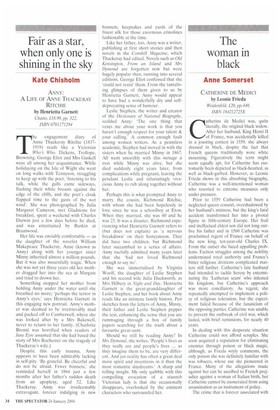Fair as a star, when only one is shining in the s
Kate Chisholm
ANNY: A LIFE OF ANNE THACKERAY RITCHIE by Henrietta Garnett Chatto, £1&99, pp. 322, ISBN 0701171294 The engagement diary of Anne Thackeray Ritchie (18371919) reads like a Victorian Who's Who, Dickens, Trollope, Browning, George Eliot and Mrs Gaskell were all among her acquaintance. While holidaying on the Isle of Wight she went on long walks with Tennyson, struggling to keep up with the poet, 'listening to his talk, while the gulls came sideways, flashing their white breasts against the edge of the cliffs, and the poet's cloak flapped time to the gusts of the wet wind'. She was photographed by Julia Margaret Cameron, met Gladstone for breakfast, spent a weekend with Charles Darwin just a few days before he died, and was entertained by Ruskin at Brantwood.
Her life was enviably comfortable — as the daughter of the novelist William Makepeace Thackeray, Anne (known as Anny) along with her younger sister Minny inherited almost a million pounds. But it was also mournfully tragic. When she was not yet three years old her mother dragged her into the sea at Margate and tried to drown her.
Something stopped her mother from holding Anny under the water until she breathed no more; 'perhaps the terror in Army's eyes,' says Henrietta Garnett in this engaging new portrait. Army's mother was deemed to be irretrievably mad and packed off to Camberwell, where she was looked after by a Mrs Bakewell, never to return to her family. (Charlotte Bronte was horrified when readers of Jane Eyre assumed that she had based the story of Mrs Rochester on the tragedy of Thackeray's wife.) Despite this early trauma. Anny appears to have been admirably lacking in self-pity. 'Be grateful. Be cheerful and do not be afraid. Fewer bonnets,' she reminded herself in 1864 just a few months after her father's sudden death from an apoplexy, aged 52. Like Thackeray, Anny was irredeemably extravagant, forever indulging in new bonnets, keepsakes and yards of the finest silk for those enormous crinolines fashionable at the time.
Like her father, too, Anny was a writer, publishing at first short stories and then novels in the Cornhill Magazine, which Thackeray had edited. Novels such as Old Kensington, From an Island and Mrs Dymond are forgotten now but were hugely popular then, running into several editions. George Eliot confessed that she 'could not resist' them. From the tantalising glimpses of them given to us by Henrietta Garnett, Anny would appear to have had a wonderfully dry and selfdeprecating sense of humour.
Leslie Stephen, the writer and creator of the Dictionary of National Biography, scolded Anny: 'The one thing that vexes me about your work is that you haven't enough respect for your talent & your calling.' A common enough fault among women writers. As a penniless academic, Stephen had moved in with the sisters when he married Minny in 1867. All went smoothly with this menage a trots while Minny was alive, but she died suddenly eight years later, from complications while pregnant, leaving the petulant Leslie and infuriatingly vivacious Anny to rub along together without her.
Perhaps this is what prompted Anny to marry the cousin, Richmond Ritchie, with whom she had been hopelessly in love since he was a schoolboy at Eton. When they married, she was 40 and he was 23. It was a disaster, Richmond experiencing what Henrietta Garnett refers to (but does not explain) as 'a nervous breakdown' on their honeymoon. They did have two children, but Richmond later succumbed to a series of affairs. Anny ruefully admitted many years later that she 'had not loved Richmond enough to say no'.
She was immortalised by Virginia Woolf, the daughter of Leslie Stephen and his second wife Julia Duckworth, as Mrs Hilbery in Night and Day. Henrietta Garnett is the great-granddaughter of Leslie Stephen, and her book about Anny reads like an intimate family history. Pen sketches from the letters of Anny, Minny, their father and Leslie Stephen pepper the text, enhancing the sense that you are rummaging through a box of family papers searching for the truth about a favourite great-aunt.
Should we still be reading Anny? In Mrs Dymond, she writes, 'People's lives as they really are and people's lives ... as they imagine them to be, are very different. And yet reality has often a great deal more spirit and inventions in it than the most romantic daydreams.' A sharp and telling insight. My only quibble with this compelling evocation of a staunch Victorian lady is that she occasionally disappears, overlooked by the eminent characters who surrounded her.


























































 Previous page
Previous page